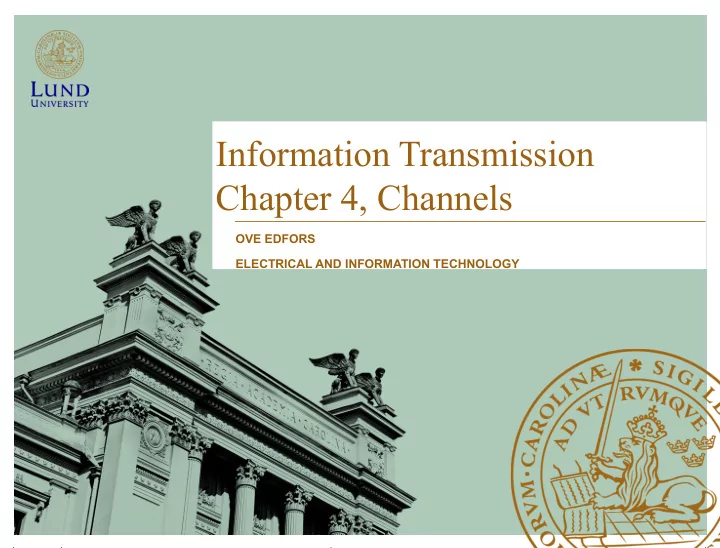

Information Transmission Chapter 4, Channels OVE EDFORS ELECTRICAL AND INFORMATION TECHNOLOGY
Learning outcomes After this lecture the student should ● understand the basic properties of wired channels, such as cables – and optical fibers, know the basic properties of wireless channels, including propagation – loss in free space and antenna gains, understand how noise enters the system and how it is characterized, – understand the basic principles of how movements and multiple – wireless propagation paths create Doppler effects and fading (variations in signal strength), and be familiar with the principle of the magnetic recording channel (for – storing data). 2
Wires, cables and fibers » Coaxial cable • Twisted pair » Used for high frequency • Standard telephone line transmission » Shielded and controlled properties 3
Model of a transmission line (wire) Model of short (unit length) section of line: - resistive loss - inductance from wires - “short circuit” resistance - capacitance between wires Model of entire wireline ... unit length sections in series 4
Wires, cables and fibers • Wires and cables have quite high attenuation • Where the propagation constant is given by • Sinus in – sinus out, but with an attenuation and phase shift 5
Attenuation of a wire pair (telephone line) • For longer wire lengths the Received power [dB] attenuation is huge at higher frequencies. • They are already in place, so let’s use them… Frequency [Hz] 6
Propagation in a fiber Fibers have low attenuation (< 0.5 dB/km). Reflections inside the fiber lead to dispersion – the light pulse will Smear out in time. 7
Radio Channels – Free space 8
Free-space loss If we assume RX antenna to be isotropic: d Attenuation between two isotropic antennas in free space is (free-space loss): 9
Antenna gain • An antenna will collect its power from an effective area A . The larger antenna the more power it will collect • Similarly, it will focus its transmit power in a certain direction where the power density then will be higher 10
Free-space loss, Friis’ law Received power, with antenna gains G TX and G RX : If we write the expression in dB ... In free space, the received power decays with distance at a rate = 20 dB/decade 11
Noise sources The noise situation in a receiver depends on several noise sources Noise picked up Wanted by the antenna signal Output signal Analog Detector with requirement circuits on quality Thermal noise 12
Receiver noise: Noise sources (1) The power spectral density of a noise source is usually given in one of the following ways: 1) Directly [W/Hz] 2) Noise temperature [Kelvin] The power N of the noise is also determined by the bandwidth Here k is Boltzmann’s constant (1.38x10 -23 W/Hz) and T K is the is the temperature of the noise source in Kelvin. 13
Distribution of the noise • The noise is most often assumed to have a Gaussian distribution • With this distribution it is possible to calculate the probability that a noise sample exceeds a certain level. 14
Receiver noise: Noise sources (2) Antenna example N a Model Noise temperature Noise free of antenna 1600 K antenna Power spectral density of antenna noise is Multiply with bandwidth to get noise power 15
Multi-path propagation, Two waves Wave 1 Wave 1 + Wave 2 Wave 2 At least in this case, we can see that the interference pattern changes on the wavelength scale. 16
Small-scale fading Illustration of interference pattern from above Received power [log scale] Movement A B Position Transmitter A B Reflector 17 2013-01-21 Fredrik Tufvesson - ETIN10 17
Small-scale fading - Rayleigh fading 18
Doppler shifts v r Frequency of received signal: f f c 0 where the Doppler shift is v Receiving antenna moves with f c r cos speed v r at an angle θ relative 0 to the propagation direction of the incoming wave, which The maximal Doppler shift is has frequency f 0 . v f c max 0 19
More than one incoming wave Incoming waves from several Spectrum of received signal directions when a f 0 Hz signal is transmitted. (relative to movement or RX) RX movement 2 1 3 2 4 1 RX 4 3 All waves of equal strength in this example, for simplicity. 20
Magnetic recording • Store magnetic field with different orientation 21
SUMMARY Wires, cables and fibers ● Wirels and cables are LTI systems – Bandwidth of wires and cables depend on length – Coaxial cables can carry higher bandwidths than wires – Fibers have low attenuation – Radio channels ● Free-space propagation – Antenna gains – Friis' law – Noise properties and calculation – Multi-path propagation: Fading and Doppler shifts – Magnetic recording ● Storing messages by changing magnetization of tape – (Transmitting to another time) 22
Recommend
More recommend